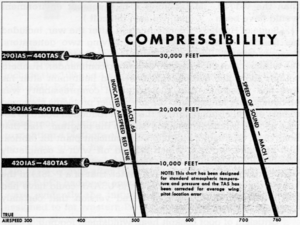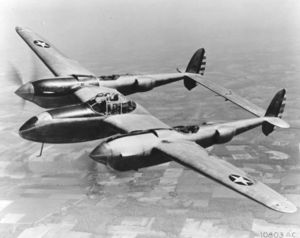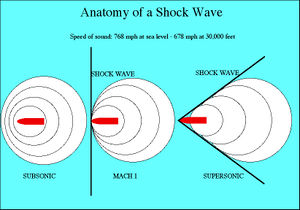First-Hand:Inception of the Experimental Research Airplane Program - Chapter 2 of The Experimental Research Airplanes and the Sound Barrier
By David L. Boslaugh, CAPT USN, Retired
Compressibility
As early as 1941, prototype fighter airplanes were running into new aerodynamic problems at speeds approaching the speed of sound. The speed of sound is the speed of propagation of a pressure wave in a medium, and in the case of air, it varies only with temperature. In the atmosphere, temperature decreases with altitude, and in a “standard atmosphere” sonic speed is 768 mph at sea level and 678 mph at 30,000 feet. A case in point was Lockheed’s new YP-38#1 twin engined fighter. At high speeds the engineering model P-38s would experience violent tail shaking, the nose would try to tuck under, the controls would become impossibly stiff and the plane would eventually enter a high speed stall. On 4 November 1941, YP-38#1 disintegrated in a dive, killing Lockheed Test pilot Ralph Virden. Investigators found the cause to be airflow that exceeded the speed of sound over parts of the airplane causing shock waves to form over the thicker area of the wings for example and other shock waves flashing in and out of being, resulting in severe buffeting and other control problems. Even though airplane speed was below the speed of sound, local air speeds could rise to sonic over the thicker parts of the craft. Air flowing past the thicker parts had to travel further than the straight line air flow in the same amount of time in order to to keep up with the general air flow. Pilots could thus not use the P-38’s full speed capacity in a dive because of compressibility effects and its disastrous consequences. [7, v-2] [6, pp.18-26]
Other high performance WW II fighters had experienced compressibility problems that had limited their performance. This included controls stiffening, control reversal, and severe buffeting at high speeds. There was a need to better understand these phenomena in order to come up with ways to overcome them. By 1943 there were also thoughts in the military services about fighters that might be abler to fly faster than sound. Concern also existed that propeller driven planes could never fly faster than about 500 mph. There was a need to know much more about transonic and supersonic flow, but there were only a few transonic and supersonic wind tunnels in the world, and there was a dearth of wind tunnel information about flight at these speeds.
So, what is a shock wave? Referring to the diagram at the left; at subsonic speeds the pressure wave disturbances created by an airplane travel away from the plane at the speed of sound and the waves expand as ever-growing spherical disturbances. But, a plane flying at the speed of sound will exactly keep up with the generated pressure waves which expand in a sphere having a diameter so great that the tightly packed group of pressure waves traveling with the airplane appear to be a flat wave called a shock wave. This layer of moving compressed air is less than a thousand of an inch thick. If the airplane should exceed the speed of sound, the pressure waves, now expanding outward with a speed less than airplane speed will appear as a thin cone of compressed air traveling along with the airplane. The shock wave from a rifle bullet passing nearby will sound like a sharp snap, whereas the shock wave from a supersonic aircraft passing overhead will be a dull boom. In actuality most supersonic airplane sonic booms are a quick double boom, with main shock waves coming from the nose and the wings.
Unanswered Questions
In 1943 there were a lot of unanswered questions about compressible flow and supersonic flight:
- German V-2 rockets had exceeded the speed of sound and remained intact; but would the structure of a manned supersonic airplane hold together?
- Would a manned supersonic airplane be controllable?
- Would airplane drag at supersonic speeds increase exponentially?
- Were there engines powerful enough to enable supersonic flight?
- Was there indeed a sound barrier that would prevent supersonic flight?
A compressibility research division, headed by aeronautical engineer John Stack, had been established at the Langley Laboratory as early as 1928. By 1936, the division had wind tunnels capable of testing small models up to supersonic speeds, and also had eight-foot and 16-foot test section tunnels that could reach up to speeds around 500 mph. There were puzzling problems with the supersonic tunnels however; such as being able to get an empty tunnel up to Mach 1, but when a model was installed in the test section, the same speed could not be achieved. This was caused, in part, by shock waves being reflected off the tunnel walls and back on to the model. Stack was not particularly happy with the knowledge coming from wind tunnel testing, and proposed a different approach: an experimental research airplane specially designed to probe the mysteries of supersonic flight. Up to this time NACA’s flight testing had focused on testing prototypes of aircraft intended for some particular operational purpose or testing existing airplanes to make improvements, or to solve some problem, rather than a plane intended specifically for research. [52, p.27, 53] [2, pp.15-16] [39 p.10]
In March 1944 the Langley Lab hosted conferences with representatives from the Navy’s Bureau of Aeronautics and the Army’s Air Technical Services Command. The subject of the meetings was Stack’s proposed experimental research airplane, and out of the meeting grew two projects. The Army agreed to sponsor a specialized research craft hopefully capable of supersonic speeds, whereas the Navy wanted to sponsor a turbojet propelled plane capable of transonic speeds; but which would eventually be a prototype for a navy fighter. In this case “transonic” speed means the speed range between that at which airflow around the wider parts of an airplane start to go sonic, up to an upper limit of a little over Mach 1. Conference members further agreed that if the services funded the research airplane projects, NACA would oversee the flight testing and would provide technical support such as their expertise in aircraft test instrumentation. Engineering test pilots would be provided by the services and by NACA, depending on the phase and purpose of the research flights. We will review the Army project first. [39, p.11, 15]
Click here to proceed to Chapter 7 of the Experimental Research Airplanes and the Sound Barrier.


